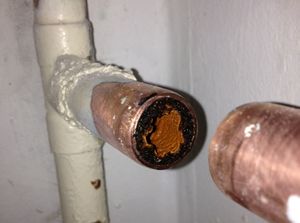WHAT IS MAGNETITE ('BLACK SLUDGE')?
Magnetite is a term used in plumbing to describe the dissolved metal held in the water
of a heating or hot water system, often seen in the form of a black sludge in radiator
water, particularly in the lower parts of heating systems such as the ground floor
or basement.
A similar red sludge known as 'hematite' also forms in heating systems but normally
remains in the top of the system, typically in the header tank (known as the 'feed
and expansion tank'), discolouring the water in the header tank with a reddish stain
and blocking the air vent and cold feed pipes.
 Effect of sludge on a central heating pipe
Effect of sludge on a central heating pipe
The effect of sludge is to narrow the opening in the pipe and as the sludge deposits
grow the pipe gradually closes up until it is blocked completely.
Both forms of sludge are formed by the corrosion of the insides of the pipework, radiators,
boiler and other metal fittings in a heating or hot water system over time.
Because magnetite is heavier than water it tends to settle in the pipes and radiators
in a heating system, building up over time to a black sludge which will eventually
restrict water flow or block waterways altogether.
HOW DO I KNOW IF MY SYSTEM HAS MAGNETITE?
A specialist plumber can use tests to check for magnetite including electronic detection
of water temperature differences across the surface of a radiator and tests for 'total
dissolved solids' in the water.
A simple check (be careful when doing this) is to run your heating system until it
is warm then go to the middle of each radiator and, using only the back of your hand,
feel the temperature of the top and bottom of the middle of each radiator.
If magnetite sludge has formed in a radiator there will be a noticable difference
in the temperature between the top of the radiator, which should be hot, and the bottom,
which will be much cooler due to sludge build-up stopping hot water from reaching
the lower parts of the radiator.
If you have a thermometer and can use this to perform the test then hold it against
the top of the radiator first and note the temperature, then reset it and position
it at the bottom of the radiator.
A temperature difference of more than 5-7oC between the top and bottom
of the radiator usually indicates a sludge blockage in the lower part of the radiator.
HOW DO I STOP MAGNETITE?
Ideally the water in a heating system should have a neutral pH value (7) or slightly
alkaline (8-9) to prevent the build-up of magnetite.
This is normally achieved through the addition of proprietary chemical inhibitors
to the heating system. These inhibitors help prevent the formation of magnetite by
keeping the water 'pH' level above 7 (the neutral level
when water is neither acidic nor alkaline)
The inhibitor should be topped up every 12-24 months, depending on the brand and the
normal acidity of the local water.
HOW DO I GET RID OF MAGNETITE?
Once magnitie has formed in your heating system the only effective solution is to
flush it out from the radiators, boiler and pipework.
This requires the use of a special powerflush pump. A powerflush pump is designed
to force a large volume of water through the heating system very quickly at a low
pressure, with the water flow reversed regularly to create turbulence which will stir
up sludge trapped at the bottom of radiators and pipes.
At the same time and the system is flushed, chemicals are added to the heating system
via the powerflush pump to dissolve the magnetite so that it can be carried out of
the heating system and dumped into a drain.
For the worst cases of magnetite each radiator needs to be islolated from the heating
system and treated individually with chemicals and powerflushing.
Severe cases are treated additionally by adding a chemical cleaner about 7 days in
advance of the powerflush and then vibrating each radiator on the heating system to
disturb the sludge compressed onto the bottom of the radiators.
Once the hot water system has been cleaned a corrosion inhibitor is added to prevent
magnetite from returning.
|